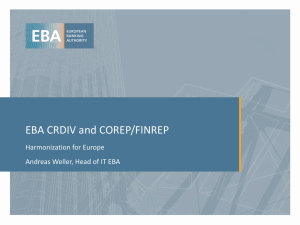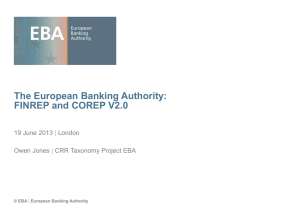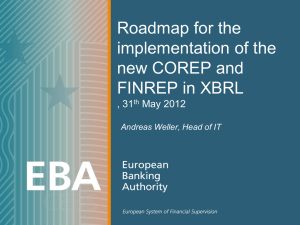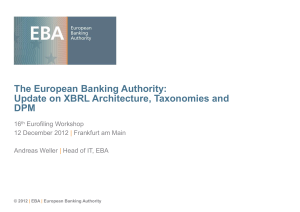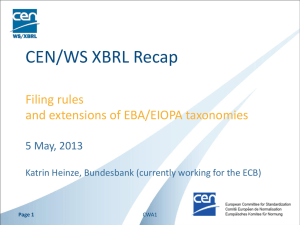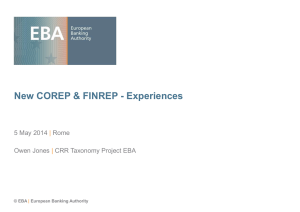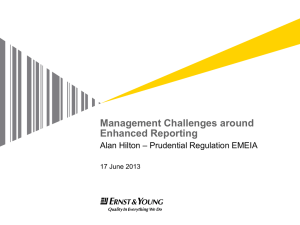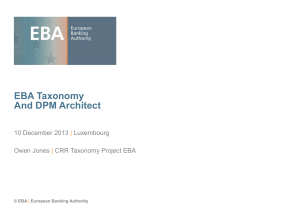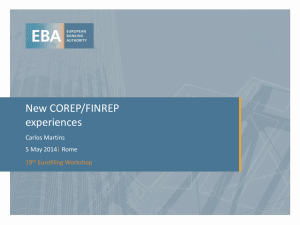EBA Technical Topics
advertisement
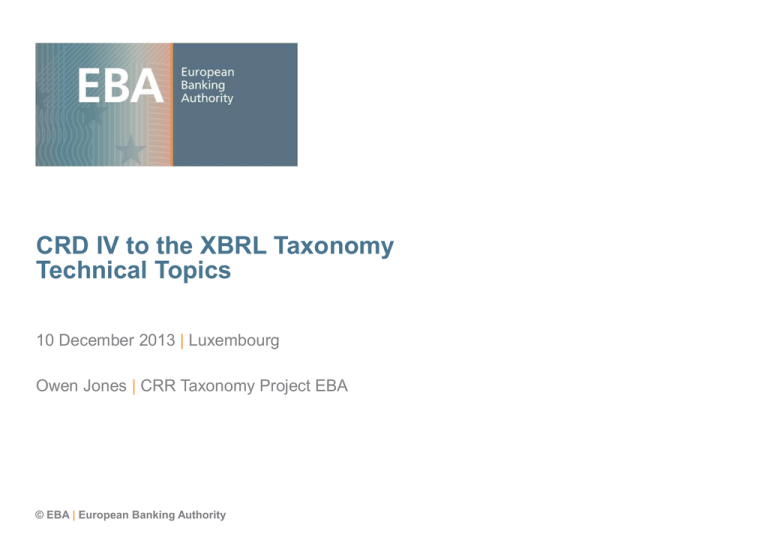
CRD IV to the XBRL Taxonomy Technical Topics 10 December 2013 | Luxembourg Owen Jones | CRR Taxonomy Project EBA © EBA | European Banking Authority Outline The taxonomy – purpose, history and structure The modules/entry points Filing Indicators Accompanying documents • Architecture document • Filing Rules • Table layout rendering • Validation rules The future 2 EBA XBRL Taxonomy Main purpose: Data transmission from ‘Competent Authorities’ to EBA “Secondary reporting” Regulations Templates Transmit to EBA DPM Taxonomy Report to SA Transmit to EBA Instructions Validations EBA Business experts Understand Requirements EBA IT experts CA IT experts Credit Institutions Many authorities will use (nearly) the same for primary reporting 3 Primary Reporting For primary reporting (Credit Institution to CAs) each CA may, at their discretion: EBA XBRL >Use the EBA taxonomy CI CA >Modify the EBA taxonomy Modified XBRL >Build their own XBRL taxonomy CI CA EBA >Not use XBRL at all Own format CI EBA XBRL CA But they all must produce EBA format XBRL files to send to the EBA 4 History of the taxonomy – how did we get here? Proof of Concept (2011) FINREP Prototype (2012) Final draft ITS/DPM (Jul 2013) Publication (01 Dec) ITS/DPM update (Oct 2013) Public Consultation (Sep/Oct 2013) EBA rollout, CA adoption or modification CRR Implementation 01 Jan 2014 First Reporting (End May 2014) 5 Contents of the taxonomy At the base – a dictionary of concepts, describing the COREP and FINREP subject area. But also, Definition and Table linkbase layer Defining the data items to be reported and layout of the reported forms Validations Defining and ensuring the basic relationships of the data items Modules Defining the units of reporting (sets of reported tables) 6 Structure of the taxonomy Dimensions Hierarchies Dictionary Domains Members Metrics Data Model layer Hierarchies Modules COREP Table Groups Tables Reporting Frameworks Reporting layer Validations FINREP Modules Tables Validations 7 Structure of the taxonomy Dimensions Hierarchies Dictionary Instance Files Domains Members Metrics Hierarchies Modules COREP Tables A B 1 2 3 C 4 5 6 Table Groups Reporting Frameworks Validations v1 v2 v3 v4 v5 v6 FINREP Modules Tables Validations 8 Conceptual groupings COREP COREP Capital Adequacy Group Solvency Credit Risk Operational Risk Market Risk Leverage Ratio LE FINREP LCR FINREP Liquidity Coverage NSFR Net Stable Funding Ratio Part 1 Part 2 Part 3 Part 4 Part 5 Large Exposures 9 High level variations For COREP >The key distinction is the consolidation / reporting level: INDIVIDUAL or CONSOLIDATED For FINREP >The key distinction is the accounting standard used: IFRS or National GAAP 10 Modules / Reports / Entry points Corep Finrep Core Individual Core Consolidated GAAP Consolidated LE Solo LE Consolidated IFRS Consolidated LCR Solo LCR Consolidated NSFR Solo NSFR Consolidated 11 Remittance Control BUT - Not every template in these groupings has to be reported by everyone, every time they report Frequency >Templates are monthly, quarterly, semi-annual or annual Submission periods >different templates have different deadlines Proportionality >Some templates only apply to some approaches >There are exit and entry criteria and materiality thresholds The possible combinations are huge… 12 Filing Indicators - flexibility • • • • Allow any subset of templates to form an XBRL-valid file Reporters indicate which templates they intended to report XBRL layer is “Flexible” rather than “Prescriptive” Receivers may check that the templates indicated are appropriate (i.e. expected) CA 1 CA 2 CA 3 CA 4 CA 5.01 CA 5.02 GS CR SA CR IRB 1 Reporter A Y Y Y Y Y Y Y Y Y Reporter B Y Y Y Reporter C Y Y Y Y Y 13 Filing Indicators Instance files MUST contain XML Tuples indicating which templates are reported <find:fIndicators> <find:filingIndicator contextRef="c1">C_26.00 </find:filingIndicator> <find:filingIndicator contextRef="c1">C_27.00 </find:filingIndicator> </find:fIndicators> 14 Control of validations ITS validation rules are included in the taxonomy as XBRL formula. These formulae check a variety of simple things e.g. > > > > > Totals are equal to the sum of a breakdown Accounting identities hold Basic calculations (ratios etc.) are correct Signs of data are correct Values for qualitative data are valid (i.e. from the right list) Evaluation of rules is controlled by the filing indicators Rules only run when filing indicators for necessary tables are set 15 Control of validations: preconditions Instance document table A reported? table B reported? Perform validation Result of assertion 1 Result of assertion 2 Result of assertion 3 Taxonomy Assertion 1 Precondition (table A reported?) Assertion 2 Assertion 3 Assertion 4 Precondition (table B reported?) Assertion 5 Application layer XBRL Processor 16 Understanding the taxonomy Several key documents accompany the taxonomy: • DPM formal model • Taxonomy Architecture • Filing Rules • DPM – Table layouts and Validation rules 17 Architecture document Describes in detail how the Data Point Model is mapped to XBRL Documents all the components of the taxonomy. Primary resource for anyone wishing to understand >What the taxonomy looks like >Why >What all the files and elements of those files are >How the taxonomy is expected to operate Primarily relevant for software developers / in house development teams 18 Filing Rules XBRL is very flexible - it can be used in a myriad of ways For each specific use, this flexibility needs to be constrained in preagreed ways, so all participants can interact effectively. We have prepared a set of “Filing rules”. Give the detail of how an instance document should be prepared. Based very closely on the work of the CEN XBRL Workshop >maximise harmonisation across European Supervisory reporting. 19 Filing Rules Include >Requirements and guidance on the preparation and validation of XBRL instance documents >To ensure that CAs can send the EBA instance documents we can process. Many CAs are likely to adopt the EBA taxonomy >Also likely to adopt in large part the EBA filing rules >Beneficial as can then send us the files they receive. >CAs may well deviate slightly from our rules / add additional restrictions to facilitate their reporting processes. 20 Filing Rules Anyone producing CRD IV XBRL instances should >Review the filing rules >(Confirm with relevant CAs where they will follow / tweak our rules) >Ensure the instances you produce can conform to the rules >Instances not following the rules will likely be rejected by the EBA /CAs 21 Table layouts and validation rules Show the • • • • layout of the reported tables DPM categorisation of the elements of the tables unique IDs for each data point. Easily comprehensible definitions of the validation rules These documents are a good way of exploring the reporting requirements without XBRL tooling / using the table or formula linkbases – and of course a help in understanding those. 22 Table layouts and validation rules 23 Validation rules • The majority of the validation rules from the ITS are expressed in XBRL. • The taxonomy documents include an Excel spreadsheet detailing the rules. • Also indicated are those rules that are NOT expressed in XBRL • These may be checked on receipt by CAs & the EBA. 24 The future Next Steps • CAs to clarify what variation of the taxonomy (or other method) they will use for data collection • Implementation in CAs and reporting institutions • Data collection • Remittance by CAs to the EBA Future Versions • Update expected in early 2013 for additional reporting area (Asset Encumbrance) • Update expected later in 2013 for use from Jan 2014 • At least yearly updates/additions after that 25 Contact information Owen Jones owen.jones@eba.europa.eu European Banking Authority Floor 18 | Tower 42 | 25 Old Broad Street London EC2N 1HQ | United Kingdom t +44 (0)20 7933 9900 f +44 (0)20 7382 1771 info@eba.europa.eu www.eba.europa.eu 26
